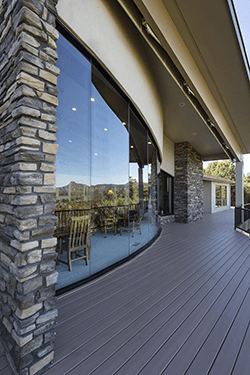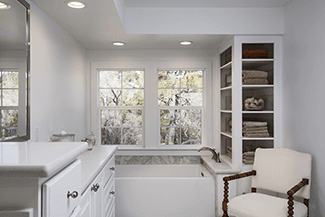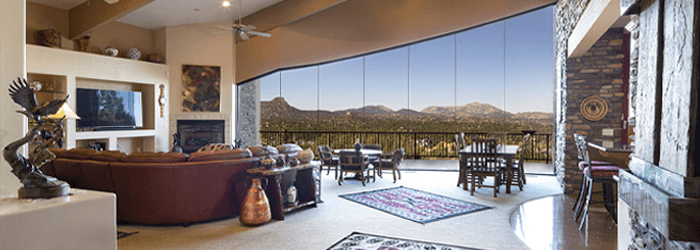Experience The Glory of Glass Walls
We design glass walls in our homes for several reasons. The most obvious being a great view.
 Expansive views in Arizona are not too hard to come by. Given our varied terrain and absolutely drop-dead gorgeous scenery, glass walls are often employed to capture that awesome view and make us feel as though we are a part of it while remaining in the comfort of our homes. The view above captures a view that begins at Thumb Butte in Prescott and sweeps to the east to include the San Francisco Peaks of Flagstaff, and on to Mingus Mountain (marking the separation between the central highlands and the Verde Valley). Who wouldn’t want to take advantage of a view like that?
Expansive views in Arizona are not too hard to come by. Given our varied terrain and absolutely drop-dead gorgeous scenery, glass walls are often employed to capture that awesome view and make us feel as though we are a part of it while remaining in the comfort of our homes. The view above captures a view that begins at Thumb Butte in Prescott and sweeps to the east to include the San Francisco Peaks of Flagstaff, and on to Mingus Mountain (marking the separation between the central highlands and the Verde Valley). Who wouldn’t want to take advantage of a view like that?
Glass walls are extremely popular remodeling projects right now on ranch style homes that were built with solid exterior walls, low roofs, and little windows. What were we thinking? What is important for a homeowner to know is glass in NOT a structural component of your home. It will not hold your house together. Your outside walls (and maybe some inside walls), must be capable of supporting not only the vertical load of your homes roof, but must also be capable of resisting all shear, or lateral forces it will be exposed to. Large expanses of glass across a large exterior wall space must be properly engineered with support columns, headers, and shear panels. None of these are typically seen when the project is completed but are absolutely necessary.
The “short” view is another reason to consider a glass wall. Short views occur in a room that is adjacent to a garden or landscape feature adjacent to our home. In this instance we are trying to meld the inside with the outside, creating a peaceful feeling for us to enjoy.
Choosing the type of glass for your wall.
 Either way, there is a lot of glass. Choosing the type of glass is step one. The compass orientation of your wall can dictate the type of glass used. Take special notice if your home faces south or west. Observe the sun as it enters your home during the changing seasons. If the sun is too direct, you may want to consider a tinted glass. There are several different degrees of tint that can be utilized. Shading also comes into play. Shading can be accomplished in a variety of ways from overhangs, or even extended roofs, to retractable curtains designed to avoid solar gain, and landscaping. Given that glass walls are not the most energy efficient, Low E glass might be a good option and that does not necessarily require heavy tinting. Glass walls can utilize different glass configurations. Often large expanses of glass are made from solid glass whose thickness depends on the structural requirements. For large residential glass about 12-foot tall, three-quarter-inch thick glass will work. There are also thicker acrylic solutions, if need be, but three-quarter-inch thick glass works in most tall and wide residential applications. Applications of any size are required to be tempered in most cases.
Either way, there is a lot of glass. Choosing the type of glass is step one. The compass orientation of your wall can dictate the type of glass used. Take special notice if your home faces south or west. Observe the sun as it enters your home during the changing seasons. If the sun is too direct, you may want to consider a tinted glass. There are several different degrees of tint that can be utilized. Shading also comes into play. Shading can be accomplished in a variety of ways from overhangs, or even extended roofs, to retractable curtains designed to avoid solar gain, and landscaping. Given that glass walls are not the most energy efficient, Low E glass might be a good option and that does not necessarily require heavy tinting. Glass walls can utilize different glass configurations. Often large expanses of glass are made from solid glass whose thickness depends on the structural requirements. For large residential glass about 12-foot tall, three-quarter-inch thick glass will work. There are also thicker acrylic solutions, if need be, but three-quarter-inch thick glass works in most tall and wide residential applications. Applications of any size are required to be tempered in most cases.
Supporting the glass.
Once you chose the glass type, the next choice will be the manner in which you support the glass. For glass walls there are again several options:
- If your goal is to have as unobstructed a view as possible, you may not want to have mullions, (vertical structural frames). You might opt for thick glass that has only perimeter metal, like aluminum, (extruded fiberglass is a frame material we particularly like), structural framework and glass sheets are sealed together with structural silicone caulk.
- If you opt to have insulated glass, that is two or more sheets of glass attached by a spacer made from acrylic, metal, plastic, or foam materials designed to create an air gap between the glass panes affording less thermal conductivity between the interior and exterior. When this glazing system is employed, a vertical structural mullion is needed. These mullions separate the insulated panels from each other and are usually forsaken for the thicker ‘Butt Glazing’ system.
Tips for cleaning large expanses of glass.
Now that you have your fantastic glazing system in place, you will need to keep it clean. Assuming most of our Rosie on the House readers tend to the DIY group, here are some tips for window cleaning large expanses of glass.
First of all, unless your glass is unusually soiled, don’t use a hose as the only means of cleaning. Using it to knock off built up grime initially is okay, but to leave it to dry allows the harsher minerals in our water to be deposited on the glass as the water evaporates. That build up will be hard to clean eventually. A couple of different cleaning solutions can be employed. Depending on your glass area, you can decide which best meets your needs.
A light dusting.
If windows are lightly soiled, light dusting with a soft bristled hand broom is a good idea before starting to clean them. Fine particles of sand can scratch the glass if rubbed into the glass while cleaning.
A bit of dish soap.
 Water with a drop or two of dish soap can work in most circumstances. When the glass is really soiled, you may want to add some vinegar to the water. Start with a 10% solution and increase from there if needed If you are using a cloth, use a microfiber cloth or even an old T-shirt and not paper or cotton towels. They usually have some sort of film on them that makes it difficult to get streak free glass. Using a bucket for the cleaning solution makes it easier to keep your cloth clean and refreshed. You can also use a commercial grade spray cleaner. These are usually a foam spray and are probably best used for a smaller area of glass.
Water with a drop or two of dish soap can work in most circumstances. When the glass is really soiled, you may want to add some vinegar to the water. Start with a 10% solution and increase from there if needed If you are using a cloth, use a microfiber cloth or even an old T-shirt and not paper or cotton towels. They usually have some sort of film on them that makes it difficult to get streak free glass. Using a bucket for the cleaning solution makes it easier to keep your cloth clean and refreshed. You can also use a commercial grade spray cleaner. These are usually a foam spray and are probably best used for a smaller area of glass.
Wait for shade.
Another pro tip is to NOT clean your glass when the sun is directly on it. The heated glass will evaporate the water in your solution leaving a soap residue or cause your foam cleaner to leave glass streaky.
Squeegee
Most window cleaning experts recommend using a squeegee. The professional squeegees have a microfiber scrubber on one side and rubber squeegee, slightly separated from the scrubber, on the other side. It will take some practice to get the best angle of the rubber squeegee on the glass for superior results. Practice will get you where you need to be though.
Check with your window manufacturer to make sure you use the best cleaning practices for your specific windows.
General maintenance tips.
Beyond cleaning, there are a few maintenance items you should undertake a couple time a year. Inspect the seals on insulated panels for any signs of deterioration of the foam or plastic parts. Larger glass areas will move more from thermal expansion and contraction than smaller frames. Condensation between the panes is a good indicator that the seal is broken. If your glass is silicone butt glazed, look for discoloration of the silicone or little gaps between the silicone and the glazing.
We hope you are enjoying your Arizona view from you glass wall! If you can, send us a photo to info@rosieonthehouse.com, we would love to share the view too.
###
ROTH Homeowner Handbook To-Do | #GlassWalls
PODCAST
Our Weekly To Do on glass walls. A feature that enhances the view small or large, but it requires structural work to install. Plus questions on concrete cost, moisture penetration in stem walls, popping floor tiles, mold and more!
Podcast Archive With Expanded Content and Resources
PHOTO CREDIT
















